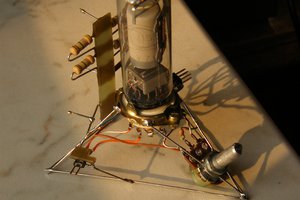
As you know, VFD is a kind of vacuum tube, not for amplification but "only for display". Similar vacuum tube can be found, for example "Magic Eye 6E5" or famous Nixie tube. These tubes are more likely original vacuum tube and requires, generally, more than 100 V plate voltage. But in the case of VFD, it will work much less voltage (still high, though) around 20V or so. This time I made simple VFD clock consisting of
(1) MCU: ATMega328P
(2) RTC NXP PCF2129AT
(3) Voltage converter (5 V to 20 V) by TI LMR62421
(4) Transistor array TF62004
(5) Shift register 74HC164, and
(6) VFD Russia IV-3A

The pinout of IV-3A VFD is compatible with IV-6 Nixie (not voltage but just pin-compatible) and also LMR62421 is with TPS61040. With shift register and transistor array, high voltage (20 V) is switched by serial data from ATMega328. Four NPN transistors (2SC1815) are 4-column switching enables dynamic driving.

I can see the time but is not so clear digit display through camera due to dynamic driving.

Just around 4 to 5 V is enough to drive it. Actual operation is shown in the following movie.. just for fun!
 kodera2t
kodera2t



 Albert van Dalen
Albert van Dalen
 Marek
Marek
 The Reverend
The Reverend
 DeepSOIC
DeepSOIC
impressive, you obviously know that russian "lamps" (also known as tubes, but in russia they are "lamps". periiod.) are da best. ever. made. :) many models achieved cult status, as for example a certain model (forgot the alphanumerical code, have to search for it), commonly known as "THE neonka" to those in the know.
there are lots of cool projects on russian electronics forums, based on lamps/tubes (and also related to microwaves, btw) that are well beyond my skill level and abilities :( but your skill levels is very very high, imho, of course. i need a partner like you :) do you speak russian? if you do i'll send you a link for a video (pretty old, late 80s, still mindblowing) in russian that shows amazingly huge, both in breadth and in dept, potential largely untapped outside russia. hmmmm, based on my understanding of japanese culture, perhaps all those projects may find success in japan...